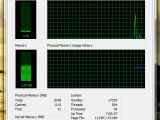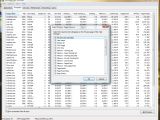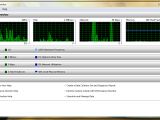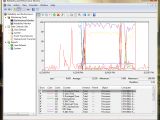There is more to performance monitoring in Windows Vista than the old and familiar Windows Task Manager, while there is little doubt in my mind that this is by far the most popular system activity measuring tool for the Windows platform, not just the latest version of the Microsoft operating system.
Similar to the Windows Task Manager, the Performance Monitor is also a survivor of Windows XP. An integer part of the reliability and Performance Monitor in Windows Vista, the tool represents the evolution of XP's System Monitor. But unlike the Windows Task Manager ? a tool designed for general performance tracking and recording ? the Performance Monitor component addresses IP professionals and covers every nook and cranny of the operating system.
The Reliability and Performance Monitor brings to the table not only the Performance Monitor tool, but also a component that Microsoft introduced to the Windows platform with Windows Vista: Resource Overview. In essence, all these three Vista components are real time performance monitoring tools, but separated by nuances and attention to detail.
Same Old... Windows Task Manager
But with a modified access method. Pressing Ctrl + Alt + Delete in Windows Vista will allow users to manage account details, without opening the tool. In order to execute Windows Task Manager, the Ctrl + Shift + Esc combination of keys has to be used. Since this was also valid in Windows XP, I expect many users to be accustomed to it, although I have to confess that I was a Ctrl + Alt + Delete guy.
Windows Task Manager is a component associated with unresponsive applications and processes in Windows. It delivers immediate access to hanging or stopped tasks and processes, and an even faster way to terminate them, and regain Windows functionality. This aspect has changed little in Windows Vista, and as such, this will continue to be the primary role of the tool.
Still, Windows Task Manager does manage to offer an insight into the resource consumption and activity of your system. Via its assessment of tabs, Vista users will be able to identify the applications and processes in use, but also the active services, performance information, network data and active users.
The easiest way to find the application or process that is a resource hog is to turn to the Windows Task Manager. The Performance tab delivers information about the CPU usage, the free and cached volumes of physical memory, together with CPU and RAM usage history. As you can see from the adjacent image, a total of 1.08 GB of RAM on my machine are cached, with very few processes active.
The reason for this is simple and it has to do with the way Microsoft has enhanced system resource management in Windows Vista. The operating system has cached over half of my memory pre-loading the various applications that I use on a day-to-day basis. All users should know that uncached RAM is synonymous with unused RAM.
The Windows Task Manager menu is context sensitive and will change according to the tab that is in focus. Users will be able to slow down or speed up the update rate of the usage history, and even see graphical representations of the performances of multiple processors. By default, Windows task Manager will show just the processes directly under the control of the user, clicking on Show Processes From All Users will enable access to all the active processes.
Additionally, users can customize Windows Task Manager to deliver, as far as processes go, far more information that the default option. Under View, Select Columns there are a multitude of categories/columns that can be accessed.
Resource Monitor, the Prodigal Vista Monitoring Component
It?s a tool designed to be complementary to the Windows Task Manager. While the two components do share a collection of features, each possesses individual features that recommend specific usage. Resource Monitor can be accessed via Windows Task Manager under the Performance tab. Resource Monitor or Resource Overview, depending on how you like to refer to it, is not a stand-alone tool in the complete sense of the word, although it can be accessed as such.
I?m saying this because Resource Overview is also integrated into the Reliability and Performance Monitor Component. On top of the information offered by Windows task Manager, Resource Overview also delivers an insight into the activity of the hard disk or disks on the computer.
The Resource Monitor's purpose is to centralize data related to the activity of the processor, hard disk, network and RAM. This component offers no user customization options by comparison with the Windows Task Manger where it comes to per-process details.
Reliability and Performance Monitor, Who's Your Daddy?
If Resource Monitor is the prodigal Windows Vista monitoring component, then surely the Reliability and Performance Monitor is the father. Reliability and Performance Monitor can be accessed by entering "perfmon" in the Search Box under the Windows Vista Start menu. With the option selected press Ctrl + Shift + Enter in order to execute the tool with administrative privileges. Launching Reliability and Performance Monitor without elevation of privileges will not permit the standard user to access the complete range of functionality of the component.
Reliability And Performance Monitor can also be opened through the Advanced Tools, in Performance Information And Tools, in System And Maintenance under Control Panel. But when it comes to the Reliability And Performance Monitor I have to give you a little piece of advice. Unlike the two previous tools presented here, that can be easily handled by average users, Reliability And Performance Monitor is meant for IT professionals.
As you can see from the image on the left, or from your own copy of Windows Vista, Reliability And Performance Monitor allows you access to information from the Resource Overview tool discussed above, but also offers its own advanced Performance Monitor and Reliability Monitor components, along with Data Collector Sets and Reports.
The Windows Vista Reliability And Performance Monitor is in a league of its own when it comes to monitoring the performances of the systems, and it is the most complex tool that users have available by default with the operating system for tracking, recording and reporting.

 14 DAY TRIAL //
14 DAY TRIAL // 



